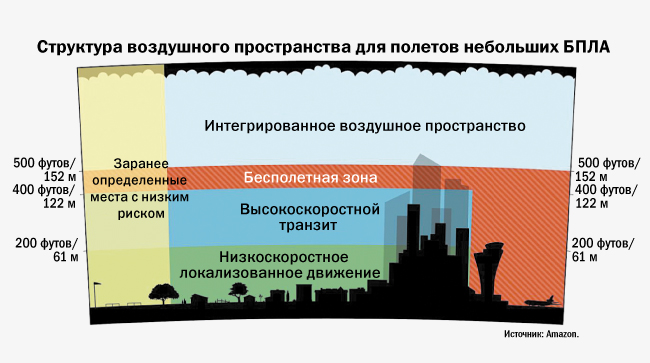Google and Amazon offer their division of airspace into zones for UAV flights
Google and Amazon are working on the legislative regulation of UAV flights so that private companies can manage this process instead of the US Federal Aviation Administration (FAA). The essence of the proposals of both companies comes down to the classification of drones, depending on the technical capabilities of the devices and providing them with the right to fly at a height of a strictly defined range. Private companies should provide air navigation services for drones in order to avoid air collisions.
Amazon suggests dividing all types of drones into 4 classes: basic, good, better and best .
Graphically, the Amazon proposal is as follows:

In addition, Amazon proposes to divide the airspace in height for flights of drones of the corresponding classes.
The division of airspace at altitude is presented in the infographic below:

Amazon suggests dividing all types of drones into 4 classes: basic, good, better and best .
- basic - drones for flying in the line of sight with a low level of risk.
- good - simple radio-controlled devices for flying to the line of sight at a height of up to 60 meters. Such drones must be able to communicate their identification, location and activity status using the V2V ( vehicle-to-vehicl ) protocol . Flights of vehicles of this class are allowed only over rural or sparsely populated areas.
- better - drones for flights at altitudes up to 120 meters, which have the functions of autopilot and automatic collision avoidance via the V2V protocol. Flights permitted over suburban areas
- best - advanced drones with the functions of online flight path planning, data transmission about possible obstacles, data reception and transmission using automatic zone surveillance-broadcasting technology ( ADS-B ), landing at suitable sites. Such devices could already fly over a city building at an altitude of not more than 120 meters.
Graphically, the Amazon proposal is as follows:

In addition, Amazon proposes to divide the airspace in height for flights of drones of the corresponding classes.
- an area of up to 61 meters is intended for ground research: geodetic surveying, photographing, and object inspection. The transit of drones at such altitudes is not provided. These include apparatus classes basic and good.
- an area of 61 to 122 meters is reserved for drones of the better and best classes, equipped with special equipment, in accordance with certain standards and instructions.
- An area from 122 to 152 meters is proposed to leave a buffer. Drones of any classes are prohibited here, unless it is necessary to avoid a collision.
The division of airspace at altitude is presented in the infographic below:

